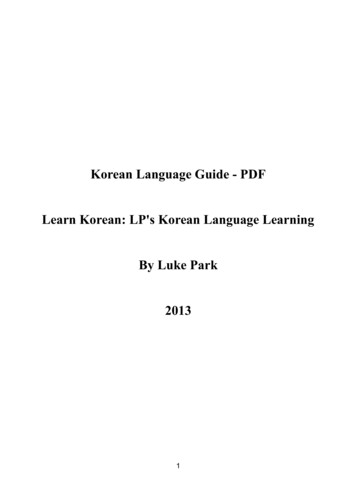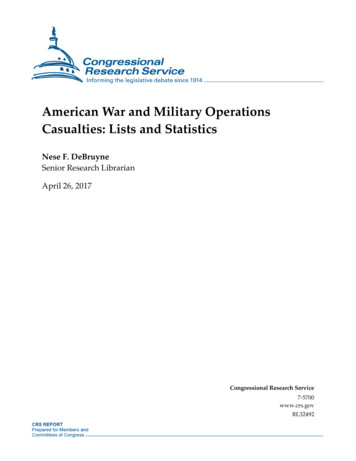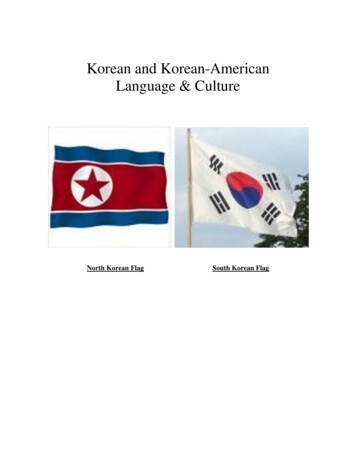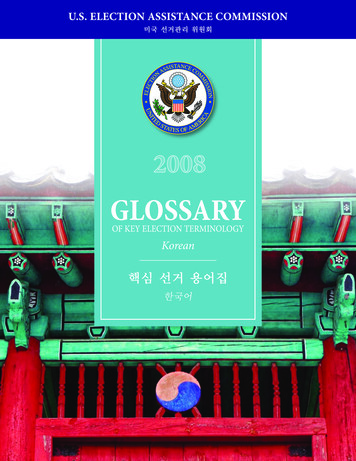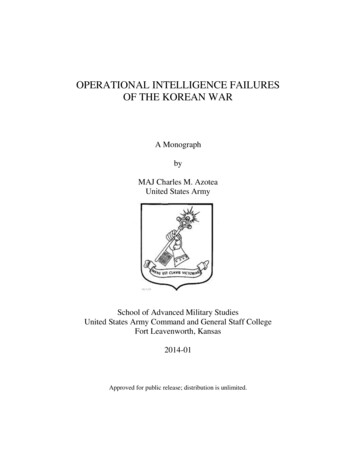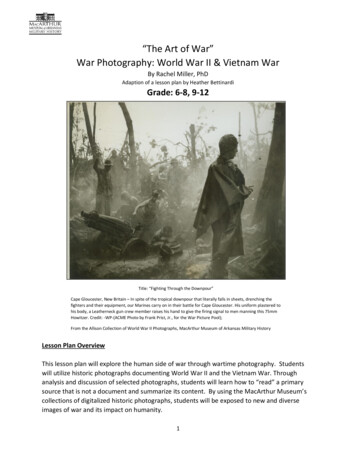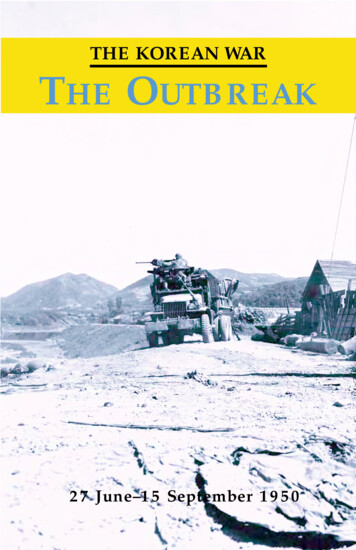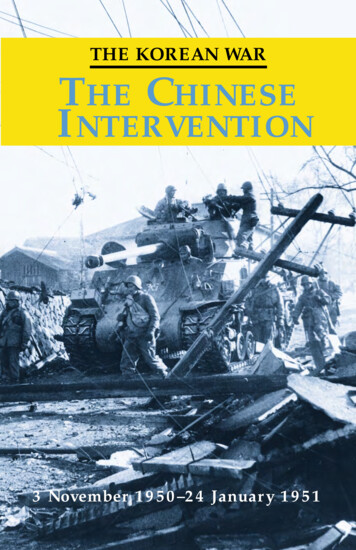
Transcription
THE KOREAN WARTHE CHINESEINTERVENTION3 November 1950–24 January 1951
IntroductionThe Korean War was the first major armed clash between FreeWorld and Communist forces, as the so-called Cold War turned hot. Thehalf-century that now separates us from that conflict, however, hasdimmed our collective memory. Many Korean War veterans have considered themselves forgotten, their place in history sandwiched between thesheer size of World War II and the fierce controversies of the VietnamWar. The recently built Korean War Veterans Memorial on the NationalMall and the upcoming fiftieth anniversary commemorative eventsshould now provide well-deserved recognition. I hope that this series ofbrochures on the campaigns of the Korean War will have a similar effect.The Korean War still has much to teach us: about military preparedness, about global strategy, about combined operations in a militaryalliance facing blatant aggression, and about the courage and perseverance of the individual soldier. The modern world still lives with the consequences of a divided Korea and with a militarily strong, economicallyweak, and unpredictable North Korea. The Korean War was waged onland, on sea, and in the air over and near the Korean peninsula. It lastedthree years, the first of which was a seesaw struggle for control of thepeninsula, followed by two years of positional warfare as a backdrop toextended cease-fire negotiations. The following essay is one of fiveaccessible and readable studies designed to enhance understanding ofthe U.S. Army’s role and achievements in the Korean conflict.During the next several years the Army will be involved in manyfiftieth anniversary activities, from public ceremonies and staff rides toprofessional development discussions and formal classroom training.The commemoration will be supported by the publication of variousmaterials to help educate Americans about the war. These works willprovide great opportunities to learn about this important period in theArmy’s heritage of service to the nation.This brochure was prepared in the U.S. Army Center of MilitaryHistory by Richard W. Stewart. I hope this absorbing account, with itslist of further readings, will stimulate further study and reflection. Acomplete listing of the Center of Military History’s available workson the Korean War is included in the Center’s online OHN S. BROWNBrigadier General, USAChief of Military History
The Chinese Intervention3 November 1950–24 January 1951They came out of the hills near Unsan, North Korea, blowing buglesin the dying light of day on 1 November 1950, throwing grenades andfiring their “burp” guns at the surprised American soldiers of the 8thCavalry Regiment, 1st Cavalry Division. Those who survived the initialassaults reported how shaken the spectacle of massed Chinese infantryhad left them. Thousands of Chinese had attacked from the north, northwest, and west against scattered U.S. and South Korean (Republic ofKorea or ROK) units moving deep into North Korea. The Chineseseemed to come out of nowhere as they swarmed around the flanks andover the defensive positions of the surprised United Nations (UN)troops. Within hours the ROK 15th Regiment on the 8th Cavalry’s rightflank collapsed, while the 1st and 2d Battalions of the 8th Cavalry fellback in disarray into the city of Unsan. By morning, with their positionsbeing overrun and their guns falling silent, the men of the 8th Cavalrytried to withdraw, but a Chinese roadblock to their rear forced them toabandon their artillery, and the men took to the hills in small groups.Only a few scattered survivors made it back to tell their story. Theremaining battalion of the 8th Cavalry, the 3d, was hit early in the morning of 2 November with the same “human wave” assaults of bugle-blowing Chinese. In the confusion, one company-size Chinese element wasmistaken for South Koreans and allowed to pass a critical bridge nearthe battalion command post (CP). Once over the bridge, the enemy commander blew his bugle, and the Chinese, throwing satchel charges andgrenades, overran the CP.Elements of the two other regiments of the 1st Cavalry Division,the 5th and 7th Cavalries, tried unsuccessfully to reach the isolatedbattalion. The 5th Cavalry, commanded by then Lt. Col. Harold K.Johnson, later to be Chief of Staff of the Army, led a two-battalioncounterattack on the dug-in Chinese positions encircling the 8thCavalry. However, with insufficient artillery support and a determinedenemy, he and his men were unable to break the Chinese line. Withdaylight fading, the relief effort was broken off and the men of the 8thCavalry were ordered to get out of the trap any way they could.Breaking into small elements, the soldiers moved out overland undercover of darkness. Most did not make it. In all, over eight hundred menof the 8th Cavalry were lost—almost one-third of the regiment’sstrength—in the initial attacks by massive Chinese forces, forces thatonly recently had been considered as existing only in rumor.
HyesanjinluRChMANCHURIAgjinRaCh’osan YanCHANGJINHagaru-ri (CHOSIN)ChongjuRIwonnngngch’oHungnamChRTae do’oUnsanRESRryongRngyoerTaSinuijuKuS E ASinanjuO 38 KosongTYesong RjinRP’YONGYANGJ A PA NYangyang38 KaesongSEOULSuwonOsanHongch’onSamch’okWonjuRY E L L O ’onUlchinCh’ungjuS E AAndongRKunsantongNakmKu TaejonP’ohang-dongTaeguMiryangRMasanKOREAHigh GroundAbove 200 Meters050 MILESPUSANSMokp’oKOREATRAIT
U.S. soldiers with tank make their way through the rubble-strewnstreets of Hyesanjin in November 1950. (DA photograph)Other elements of the Eighth Army were also attacked in the ensuing days, and it fell back by 6 November to defensive positions alongthe Ch’ongch’on River. However, as quickly as they had appeared, theChinese Communist Forces (CCF) disappeared. No additional attackscame. The Chinese units seemed to vanish back into the hills and valleys of the North Korean wastelands as if they had never been. By 6November 1950, all was quiet again in Korea.Strategic SettingThe large-scale Chinese attacks came as a shock to the alliedforces. After the breakout from the Pusan Perimeter and the Inch’onlandings, the war seemed to have been won. The desperate defensivefighting of June was a distant memory, as were the bloody struggles tohold the Naktong River line in defense of Pusan in August and earlySeptember. General of the Army Douglas MacArthur, the Far EasternCommand Theater Commander, had triumphed against all the odds bylanding the X Corps, consisting of the 1st Marine Division, the 7thInfantry Division, and elements of ROK Marines at the port of Inch’on5
near Seoul on 15 September. Breaking out from the Pusan Perimeterfour days later, Eighth Army defeated and then pursued the remnantsof the North Korean People’s Army (NKPA) up the peninsula by manyof the same roads over which they had retreated a mere two monthsbefore. On 29 September Seoul was declared liberated.As the victorious UN forces pursued the fleeing NKPA, MacArthurwas authorized by President Harry S. Truman to go north of the preJune boundary, the 38th Parallel, while enjoined to watch for any indications that the Soviets or Chinese might enter the war. Korea was seen bymost at the time as just part of the overall struggle with world communism and perhaps as the first skirmish in what was to be World War III.MacArthur, convinced that he could reunify all of Korea, moved hisforces north. Lt. Gen. Walton H. Walker’s Eighth Army advanced up thewest coast of Korea to the Yalu River, while Maj. Gen. Edward M.“Ned” Almond’s independent X Corps conducted amphibious landingsat Wonsan and Iwon on the east coast. Almond’s units moved up thecoast and to the northeast and center of Korea to the border with China.Until the attacks by the CCF at Unsan, the war thus seemed on the vergeof ending with the UN forces merely having to mop up NKPA remnants.In retrospect the events on the battlefield in late October and earlyNovember 1950 were harbingers of disaster ahead. They had been foreshadowed by ominous “signals” from China, signals relayed to theUnited States through Indian diplomatic channels. The Chinese, it wasreported, would not tolerate a U.S. presence so close to their borders andwould send troops to Korea if any UN forces other than ROK elementscrossed the 38th Parallel. With the United States seeking to isolateCommunist China diplomatically, there were very few ways to verifythese warnings. While aware of some of the dangers, U.S. diplomats andintelligence personnel, especially General MacArthur, discounted therisks. The best time for intervention was past, they said, and even if theChinese decided to intervene, allied air power and firepower would cripple their ability to move or resupply their forces. The opinion of manymilitary observers, some of whom had helped train the Chinese to fightagainst the Japanese in World War II, was that the huge infantry forcesthat could be put in the field would be poorly equipped, poorly led, andabysmally supplied. These “experts” failed to give full due to the revolutionary zeal and military experience of many of the Chinese soldiers thathad been redeployed to the Korean border area. Many of the soldierswere confident veterans of the successful civil war against the NationalistChinese forces. Although these forces were indeed poorly supplied, theywere highly motivated, battle hardened, and led by officers who wereveterans, in some cases, of twenty years of nearly constant war.6
Perhaps the most critical element in weighing the risks of Chineseintervention was the deference paid to the opinions of GeneralMacArthur. America’s “proconsul” in the Far East, MacArthur was theAmerican public’s “hero” of the gallant attempt to defend Bataan andCorregidor in the early days of World War II, the conqueror of theJapanese in the Southwestern Pacific, and the foreign “Shogun” ofJapan during the occupation of that country. He was also the architectof the lightning stroke at Inch’on that almost overnight turned the tideof battle in Korea. When he stated categorically that the Chinesewould not intervene in any large numbers, all other evidence of growing Chinese involvement tended to be discounted. MacArthur and hisFar Eastern Command (FEC) intelligence chief, Maj. Gen. Charles A.Willoughby, continued to insist, despite the CCF attacks at Unsan andsimilar attacks against X Corps in northeastern Korea, that theChinese would not intervene in force. On 6 November the FEC continued to list the total of Chinese troops in theater as only 34,500, whereas in reality over 300,000 CCF soldiers organized into thirty divisionshad already moved into Korea. The mysterious disappearance ofChinese forces at that time seemed only to confirm the judgment thattheir forces were only token “volunteers.”The overall situation in early November 1951 was unsettled, butUN forces were still optimistic. The North Korean Army had beenthoroughly defeated, with only remnants fleeing into the mountains toconduct guerrilla warfare or retreating north toward sanctuary inChina. Eighth Army positions along the Ch’ongch’on River, halfwaybetween the 38th Parallel and the Yalu, were strong. The 1st CavalryDivision had admittedly taken a beating, but two regiments were stillin good condition, while the 24th and 25th Infantry Divisions had generally recovered from their earlier trials. On the Eighth Army’s rightflank, the 2d Infantry Division was in a position to backstop the vulnerable ROK 6th and 8th Divisions. In northeastern Korea, the unitsunder X Corps were fresh and, in the case of the 1st Marine Division,at full strength. By the first week of November, despite the surpriseattacks by what were still classed as small Chinese volunteer units, theUnited Nations forces as a whole were well positioned and lookingforward to attacking north to the Yalu to end the war and being “homeby Christmas.”OperationsThe U.S.-led United Nations Command (UNC) had extensiveforces at its disposal in Korea in November 1950. The major UNC7
ground combat strength consisted of Eighth Army headquarters, aROK army headquarters, 6 corps headquarters (3 U.S., 3 ROK), 18infantry division equivalents (10 ROK, 7 U.S. Army, and 1 U.S.Marine), 3 allied brigades, and a separate airborne regiment. The totalcombat ground forces were around 425,000 soldiers, including some178,000 Americans. In addition, of course, the UNC had major air andnaval components in support.Forces opposing the UN in early November were organized undera combined headquarters staffed by North Korean and Chinese officers. Kim Il Sung, the leader of North Korea, was also commander ofthe North Korean Armed Forces based at Kanggye, deep in the mountains of north central Korea. On paper, the North Korean forces consisted of 8 corps, 30 divisions, and several brigades, but in fact only 2corps totaling some 5 weak divisions and 2 depleted brigades were inactive operations against UN forces. The IV Corps with one divisionand two brigades opposed the ROK I Corps in northeastern Korea,while the II Corps with 4 scattered and weakened divisions wasengaged in guerrilla operations in the Taebaek Mountains both aboveand below the 38th Parallel. The remainder of the surviving NorthKorean Army elements were resting and refitting in the sanctuary ofManchuria or along the border in north central Korea, away from themain lines of UN advance along the east and west coasts of the peninsula. Most of the enemy striking power was contained in the 300,000strong Chinese People’s Liberation Army (PLA). They had enteredKorea during the last half of October, undetected by FEC intelligenceassets. The stage was set for the near-destruction of Eighth Army andthe abandonment of the military attempt to reunify Korea.Convincing himself and his Far Eastern Command staff that theChinese would not intervene in force, General MacArthur was determined to reunify Korea and change the balance of power in Asia. TheJoint Chiefs of Staff, impressed by MacArthur’s stunning triumph atInch’on and the collapse of the NKPA during the following month,were in no position to argue. Despite some misgivings, they allowedMacArthur a generous, although not unrestrained, latitude to pursuehis vision of winning the war before the year was out. Even PresidentTruman, not a man to defer easily to anyone, apparently felt thatMacArthur should be allowed to carry on the war and finish off theNorth Koreans.To implement MacArthur’s objectives, General Walker draftedplans for his Eighth Army to advance quickly against the crumblingopposition all the way to the Yalu River on the Chinese frontier.Meanwhile, General Almond and his X Corps, separated from Eighth8
HyesanjinluRChMANCHURIATo CHONGJINgjinRXXXXaCh’osan YanCHANGJINHagaru-ri (CHOSIN)IwonXXonCh’onTaed gch’RChongjuRESRryongng RyoerTaSinuijuKugon7RHungnamS E ASinanjuXXXO FWonsanXJ A PA NXX1 on38 KansongaYesong RImjin3KosongYangyang38 KaesongSEOULSuwonOsanXXXXEIGHTHS E AHongch’onSamch’okWonjuRY E L L O ’onUlchinCh’ungjuAndongRKunsantongNakmKu TaejonP’ohang-dongTaeguMiryangRMasanRACE TO THE YALUHigh GroundAbove 200 Meters050 MILESPUSANSMokp’oKOREATRAIT
Army by the virtually impassable Taebaek Mountains, planned a similar series of widely scattered offensive spearheads on the eastern sideof the peninsula in order to beat Eighth Army to the Yalu. Beginningin mid-October, each major force sought to take as much terrain aspossible. Eighth Army units occupied P’yongyang, the North Koreancapital, about seventy-five miles north of the 38th Parallel, on 19October. Almond’s X Corps came ashore at Wonsan on the other sideof the peninsula on 25 October and moved quickly inland. Only theunforeseen incidents at Unsan, about sixty miles north of P’yongyang,at the end of October caused both forces to pause and reconsider thewisdom of such an all-out offensive.With the cessation of Chinese attacks on 6 November, Walker andAlmond began planning to resume the offensive. Elements of X Corpsunits even reached the Yalu River at Hyesanjin on 21 November andSingalp’ajin on the twenty-eighth. Although these were only minor“reconnaissance-in-force” elements, both Walker and Almond plannedto follow through with major offensives of all their forces beginningon 24 and 27 November, respectively.In the west, Eighth Army began its offensive north from its positions along the Ch’ongch’on River, some f ifty miles north ofP’yongyang, on 24 November. Its initial objective was to reestablishcontact with any remnant North Korean forces or Chinese volunteerunits. The I Corps (24th Infantry Division, ROK 1st Infantry Division,and British 27th Commonwealth Brigade) was on Eighth Army’s left,IX Corps (25th Infantry Division, 2d Infantry Division, and theTurkish Brigade) was in the center, while the ROK II Corps, with its6th, 7th, and 8th Infantry Divisions, was on the eastern flank. The 1stCavalry Division and the British 29th Infantry Brigade were inreserve, along with the U.S. 187th Regimental Combat Team(Airborne).The I Corps attacked west and northwest toward Chongju andT’aech’on, while IX Corps headed north toward Unsan, Onjong, andHuich’on. The ROK II Corps began moving toward the northeast andinto the Taebaek Mountains on the Eighth Army’s right flank that separated Eighth Army from X Corps. All advancing units generallyreceived only scattered small-arms fire, and in most instances theymoved unopposed toward their objectives. A few miles from Unsan,elements of the 25th Division discovered thirty U.S. soldiers missingsince the 8th Cavalry’s battle with the Chinese weeks before. They hadbeen captured and then released by the Chinese and suffered fromwounds and frostbite, but they were alive. By 25 November all unitswere reporting that they had reached their objectives, although they10
also reported increasing enemy resistance and even some local counterattacks. However, optimism still prevailed. Eighth Army thusplanned to resume its offensive in conjunction with the planned attackof X Corps in the east beginning on 27 November.The Battles Along the Ch’ongch’onOn the night of 25 November the Chinese struck Eighth Armyagain. The first CCF attacks hit the 9th and 38th Infantries of the U.S.2d Infantry Division about eighteen miles northeast of Kunu-ri alongthe Ch’ongch’on River. Charging to the sounds of bugles, the Chinese40th Army found gaps between the units and struck their flanks. Theyhit units on both sides of the river just south of a low mountain called,ironically, Chinaman’s Hat. Infiltrators also attacked elements of the23d Infantry just behind the 9th Infantry. The Chinese took heavycasualties and were forced to suspend their attack in the early morninghours, only to resume just before dawn. Vigorous U.S. counterattacksrestored most of the main line positions. Attacks also were pressedagainst the U.S. 25th Infantry Division to the 2d Division’s left,prompting a now-alerted U.S. command to cancel the advance plannedfor 26 November. Suddenly on the defensive, U.S. soldiers dug in andconsolidated their positions while waiting for new Chinese attacks.Eighth Army’s situation was complicated by the fact that theChinese broke through elements of the ROK II Corps on the army’sright wing. They penetrated the ROK front in several places, establishing roadblocks to the rear of ROK units, cutting them off and creatingpanic. By noon on the twenty-sixth the ROK II Corps front had folded,exposing Eighth Army’s entire flank.Reacting quickly, Walker sent the 1st Cavalry Division, at thattime guarding supply installations and routes in Eighth Army’s rear,and the Turkish Brigade, in IX Corps reserve, forward to protect possible Army lines of retreat. Farther west, Walker halted the 24thDivision and prepared to conduct an active defense all along his lines.Although his intelligence officer (G–2) raised the estimate of Chinesetroops in the area from 54,000 to 101,000, Walker still did not realizethe size of the Chinese offensive. No one did. FEC headquarters merely reported to Washington that “a slowing down of the UN offensivemay result” from these new attacks.Late on the twenty-sixth Chinese forces struck again on the EighthArmy’s right flank, with the goal of exploiting the collapse of the ROKII Corps while attempting to flank the entire Eighth Army from theeast. Attacking heavily in the east and center sections of the UN line,the Chinese threw five field armies into the fight while sending another11
Chinese Communist infantry “volunteers” advance innorthern Korea in 1950. (China Today [Beijing:China Social Studies Publishing Co., 1990])against the 24th Division to the west on a holding mission. Attacksagainst the ROK 1st Division drove that unit back and soon exposed theflanks of both the U.S. 24th and 25th Divisions. Only a rapid readjustment of forces plugged this gap and stabilized the situation by earlyevening on 27 November. However, the situation was growing grim. Bymid-afternoon on the twenty-eighth all U.S. and ROK units were inretreat. Attempts by the 2d Division to hold the line and by the 1stCavalry Division and Turkish Brigade to restore Eighth Army’s rightflank were in vain. Two Chinese Armies, the 42d and 38th, were pouring through the broken ROK lines to Eighth Army’s east and threatening to envelop the entire force. Walker’s only hope was to bring off afighting withdrawal of his army deep behind the Ch’ongch’on Riverline, below the gathering Chinese thrust from the east.The withdrawal of Eighth Army units was made more difficult bythe thousands of fleeing Korean refugees who blocked the roads. Inaddition, the hordes of refugees gave excellent cover to Chinese andNorth Korean infiltrators, who often dressed in Korean clothing, wentthrough U.S. checkpoints, and then turned and opened fire on the startled Americans. The tactics repeated those used by the North Koreansduring the initial invasion of the South and were often equally effective.One 7th Cavalry company commander was killed and eight of his menwounded by enemy infiltrators throwing hand grenades. As in the summer, Eighth Army orders directed that refugees be diverted from main12
roads, escorted by South Korean police, and routed around allieddefensive lines, although the strictures were often difficult to enforce.The brunt of the renewed enemy attacks fell on the exposed U.S.2d Infantry Division. With his division almost cut off from the rest ofthe Army, Maj. Gen. Laurence B. “Dutch” Keiser relied upon theTurkish Brigade to protect his right flank as he prepared to withdrawfrom Kunu-ri. The Chinese, however, bypassed the Turks, whoremained concentrated at Kaech’on, ten miles to the west of Kunu-ri,and established roadblocks on the 2d Division’s withdrawal route tothe south. These roadblocks, combined with attacks against U.S. andROK troops north and northeast of Kunu-ri, proved a lethal combination. As the 2d Division began its withdrawal under pressure on themorning of the thirtieth, it found itself literally “running the gauntlet”as its trucks and vehicles were trapped on a congested valley roadunder fire from Chinese positions on the high ground to the east andwest. Air strikes helped but could not dislodge the Chinese troops asthey poured rifle and machine-gun fire into the slow-moving Americanvehicles. Soldiers were often forced to crouch in the ditches as theirvehicles were raked with enemy fire; while hundreds were killed orwounded, others were forced to proceed on foot down the long road toSunch’on, almost twenty miles to the south of Kunu-ri. Chinese roadblocks halted the columns repeatedly as the casualties mounted. Someartillery units were even forced to abandon their guns. The 37th FieldArtillery Battalion, for example, lost 35 men killed, wounded, or missing and abandoned 10 howitzers, 53 vehicles, and 39 trailers. As theroad became clogged with abandoned vehicles, men were forced toleave the column and make their way south as best they could. Unitintegrity in some places broke down under the murderous fire. Finally,late on 30 November, the last units closed on Sunch’on and the shattered Eighth Army established a hasty defensive line from Sukch’on tothe west to Sinch’ang-ni in the east, some twenty-five miles south oftheir initial positions on the Ch’ongch’on River line.The battles along the Ch’ongch’on River were a major defeat forthe Eighth Army and a mortal blow to the hopes of MacArthur and others for the reunification of Korea by force of arms. The 2d Divisionalone took almost 4,500 battle casualties from 15 to 30 November,most occurring after the twenty-fifth. It lost almost a third of itsstrength, along with sixty-four artillery pieces, hundreds of trucks, andnearly all its engineer equipment. While the rest of Eighth Army hadnot been hit as hard, with the possible exception of the ROK unitswhose total losses will probably never be known, there was no doubtabout the magnitude of the reverse. The U.S. 1st Cavalry, 24th and 25th13
h 'onRHuicgcXXXXPLA 40onXXXXPLA 39Ch'XXXXPLA 66T'aech'on24351112IXXXI IX24PLA 502712Chongju21Pakch'on 35ROK 11925R'ongchAnjuSinanju24Kunu-riI IXTurkishBdeKaech'onTaedonSamso-riXXav7 CavSunch'on25–28 November 19508 CavEighth Army Front, Evening, 25 Nov(Arabic Numerals Identify Regiments)Chinese Attacks, Night,25 NovYongyuChinese Attacks, Night, 26–28 NovSongch'onEighth Army Front, 28 NovHigh Ground Above 500 Feet20To P'YONGYANGMilesInfantry Divisions, and the ROK 1st Infantry Division were still relatively intact, but the U.S. 2d Infantry Division, the Turkish Brigade, andthe ROK 6th, 7th, and 8th Infantry Divisions were shattered units thatwould need extensive rest and refitting to recover combat effectiveness.Although not closely pursued by the Chinese, Walker decided that hisarmy was in no shape to hold the Sukch’on–Sinch’ang-ni line and14gRROK 6 Div1C0IITo2BATTLE OF THE CH'ONGCH'ONSukch'onROK9 Ipsok
ordered a retreat farther southbefore his forces could beenveloped by fresh Chinese attacks.h'onXXX CorpsThe Chinese offensive of lateNovember destroyed Eighth Armyplans to push all the way to theXXXXYalu. They also stymied the otherPLA 42Rarm of the offensive: the attack ofTaedongXXXXPLA 38X Corps and the ROK I Corps up5the eastern coast and center of the81021peninsula. General Almond, following the intent of GeneralROK7ROMacArthur to push vigorouslyK8against the retreating foe, hadokch'onplanned a multipronged operationYongdong-niusing these two corps. The ROK ICorps, consisting of the ROK 3dand Capital Divisions, was to proceed up the coastal roads over 200Pukch'ang-nimiles northeast to Ch’ongjin and(-)then on to the Yalu, there to guardthe X Corps right flank. The XCorps was to attack north and westof the Changjin Reservoir. Its 7thInfantry Division was to occupythe center of the X Corps front andpush to the Yalu at Hyesanjin,about 160 miles north of Wonsan.On the left of the corps, the 1stMarine Division was to proceed upboth sides of the Changjin(Chosin) Reservoir, about halfwayto the border, tie in with the ROKII Corps of the Eighth Army to thewest, and then push sixty more miles north towards the Yalu atHuch’angganggu and Singalp’ajin. However, despite the urgings of theX Corps commander for more speed, 1st Marine Division CommanderMaj. Gen. Oliver P. Smith was leery about dispersing his division overtoo broad a front. He ordered his units to attack cautiously, maintaining unit integrity, and within generally supporting distances of each15
other. The terrain in this part of Korea—narrow roads often cut by gullies and valleys with imposing ridgelines and mountains surroundingthem—made it critical for units to stay together.Rounding out X Corps was the newly arrived 3d Infantry Division,which landed at Wonsan between 7 and 15 November and was augmented by a ROK marine regiment. These units were to guard thecorps rear, relieve the marines of any port protection duties, and prepare to conduct offensive operations in support of corps operations asneeded. The 3d Division faced some challenges with making a fightingteam out of its subordinate units. The 65th Infantry Regiment, filled outwith hundreds of mobilized Puerto Rican National Guardsmen, hadonly recently been assigned to the division and had not worked with thedivision staff officers before. In addition, while training in Japan, the 3dDivision’s 7th and 15th Regiments had been assigned thousands ofminimally trained Korean augmentees, called KATUSAs (KoreanAugmentees to the U.S. Army). Nonetheless, the division was fresh andconstituted the major reserve available to X Corps.In a seemingly minor change in plans, Almond ordered the 31stRegimental Combat Team (RCT) of the 7th Division to relieve the 5thMarine Regiment on the east side of the Chosin Reservoir so themarines could concentrate their forces on the west, reorienting theirdrive to the north and west of the frozen reservoir. The 31st RCT, likemost of the rest of the 7th Infantry Division, was widely scattered andarrived in its new area in bits and pieces. The roads were treacherous,trucks were in short supply, and the different battalions and artilleryassets only slowly began to assemble east of the reservoir. Althoughthe unit was called the 31st RCT, the 31st regimental commander, Col.Allan D. “Mac” MacLean, was to command the 1st Battalion of the32d Infantry along with his 2d and 3d Battalions of the 31st Infantry.The 1st Battalion, 32d Infantry, commanded by Lt. Col. Donald C.Faith, Jr., was first to reach the new positions, relieving the marines on25 November. Faith’s battalion was alone on the east side of the reservoir for a full day before other elements of Task Force (TF)MacLean—the 3d of the 31st Infa
The Korean War was the first major armed clash between Free World and Communist forces, as the so-called Cold War turned hot. The half-century that now separates us from that conflict, however, has dimmed our collective memory. Many Korean War veterans have consid-ered themselves


